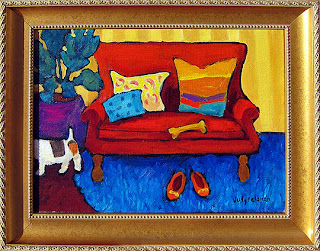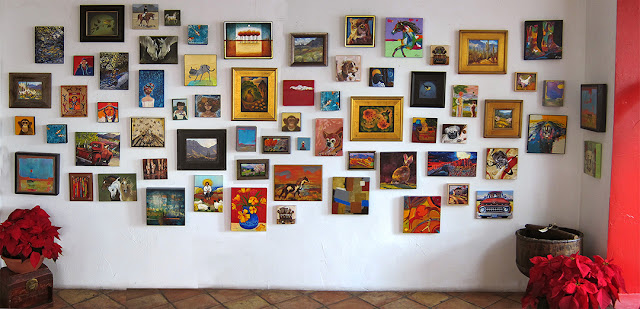By Judy Feldman | www.wildemeyer.com
Question: What kind of world is it when you don’t see black, grey and brown?
Answer: It’s the world of colorists and expressionist landscape painters.
You can certainly see my own love of color in a new painting entitled "Lola's House." I enjoy painting interiors and still lifes, where color is always welcome.
But, color isn't limited to interior settings. Landscapes, too, can push the boundaries of color, especially if artists express how they feel when they look at a scene, rather than try to reproduce it. These painters are happy! I also think that the southwestern landscape seems to encourage painters to see a bit out of the box.
Michelle Chrisman does the majority of her painting outdoors in New Mexico. "Part of the enjoyment for me is to be outside, to paint quickly and record my emotional response to what I'm seeing," she said. "I love to get in the zone, surrounded by nature, and paint alla prima, that is, wet on wet, finishing in one session." Her painting entitled "Luminous Light" is a good example of her fresh style. It's as if she took in her surroundings and expressed it in just a moment, to say how it affected her.
Michelle is a colorist who "hyper sees;" that is, she sees the hues that make up the local color others perceive. She's very interested in the effect of light and spectral color, which is defined by Wikipedia as a "color that is evoked by a single wavelength of light in the visible spectrum…" The spectrum often is divided up into named colors: red, orange, yellow, green, blue and violet.
"For me, paint is part of the experience," she said. "I want it to be luscious, to say "I'm paint, touch me!”
You can appreciate Michelle's technique and color vision in her painting entitled "Morning Light on Abiquiu Cliffs." I like the wonderful reds and yellows she uses to show warmth and light, contrasted with violet and greens to indicate the shadow side of the mountains. I think she wants us to focus on this area of the painting, as she uses much softer tones for the land and river in the foreground. So I’m guessing that it's the mountain that really grabbed her eyes. In addition to strong color, Michelle uses heavy texture with a palette knife to describe her landscape.
Barbara Gurwitz wants to create a sense of place in her landscape paintings. She takes photos and does sketches of the special places she wants to paint. But realism takes a back seat to the expression of how she felt at the time of her visit to the site. "I’m not interested in duplicating the colors of nature," she said. "I’ve always chosen colors that speak to the way I see the world, which are sometimes different from what you would expect."
When looking at one of Barbara's paintings, "October in the Mountains," I know it's a scene of a southwestern village in the foothills of a mountain range. But her strong, primary colors give this landscape great energy and a charming, folk art quality.
Barbara also seems to see through rose-colored glasses, and that may be because she uses a red ground under her paintings. "It’s a wonderful neutral," she said. She leaves the red as negative space in some areas. This is evident in most of her paintings, such as "Santa Cruz Autumn" and "View from the West." The red under-painting makes everything glow!
Leigh Gusterson learned to paint in New Jersey and was trained in the Hudson River style of plein air painting. "It was grey and humid a lot of the time, and my paintings reflected that weather." But things changed when she relocated to Taos and experienced the effect of the light there. Now, Leigh loves to push color when she paints on location at her favorite sites.
"As artists, we train our eyes to see shapes, form and color more intensely," Leigh said. "I like to share what I see with viewers of my artwork. Sometimes, it's the awesome New Mexican landscape that displays these amazing colors!"
Leigh's loose, painterly style enables her to paint expressively. We can see her wonderful technique in "Three in Ranchos" and "Down in Pilar."
Like Barbara, Leigh enjoys painting scenes of villages nestled in the mountain foothills, with their farms, houses and church. She, too, chooses to wear rose-colored glasses, and infuses some of her work with a sense of whimsy, as in "These Sheep Need a Barn."
So, if you’re living in the Southwest, take a drive to a favorite spot and look again. You, too, may see some beautiful colors you’ve never seen before.






























